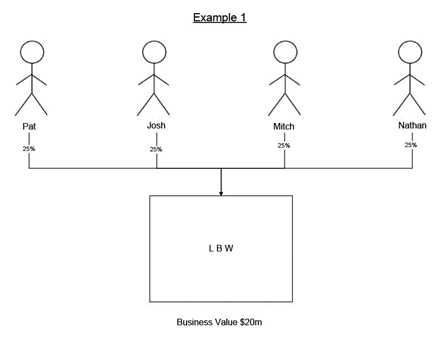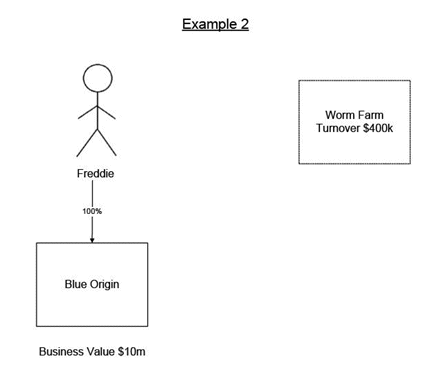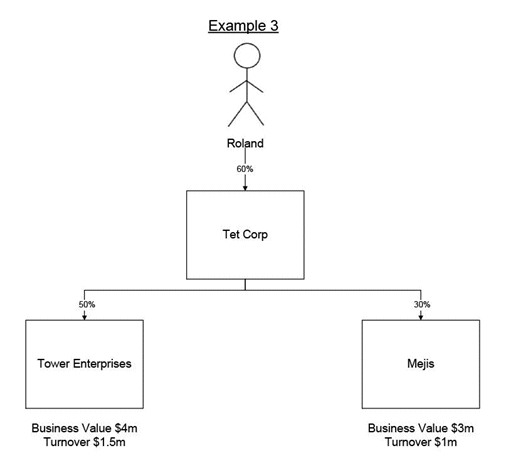Small Business Tax Concessions: Tips & Traps on Sale of Business Entities
BusinessPromoted by AustralianBiz
There are significant tax savings to be made when selling a business, or selling your ownership interest in an entity carrying on a business, where the small business capital gains tax (CGT) concessions in Division 152 of the tax legislation can be applied. Be very wary, however, of the massive changes to this landscape for sales of interests in business entities on or after 8 February 2018 - the bottom line being that meeting the tests to apply the concessions has now become more difficult, with new twists and turns that will often be extremely difficult or impossible to navigate.

What was the problem with the old rules?
In an effort to overcome perceived abuse of the old rules dealing with selling shares and units in business entities, the Government has implemented an expanded series of tests that have been added to the basic conditions for applying the CGT concessions.
The problems identified with the previous rules were that they potentially allowed:
1. A shareholder/unitholder owns between 20% and 40% of one or more large business entities and applies the CGT concessions to a sale of their shares.
Example 1 – multiple stakeholders in a large business entity
Pat, Josh, Mitch and Nathan each owned 25% of Last Blast World Pty Limited, which carried on a sporting merchandise business. They were able to sell their shares in LBW to IPL Holdings for $20m in total, but as none of them were treated as controlling LBW they would each have to count only the value of their 25% stake ($5m) when applying the $6m net asset value (NAV) test, giving them a reasonable chance of applying the concessions.

As will be seen below, the situation under the new rules will be vastly different.
2. An individual starts up or acquires a small business so as to satisfy in their own right the $2m ‘small business entity’ turnover test, where it is clear they will fail the $6m NAV test.
Example 2 – buying a small business when selling out of a larger business
Freddie owned 100% of Blue Origin Pty Limited which carried on a business of corporate wellness coaching, and sold all of his shares to Todd for $10m. In the year of the sale Freddie acquired a worm farm that supplied local anglers with bait, and had an annual turnover of $400,000. Under the old rules, Freddie could potentially rely on the newly acquired business to classify himself as a “small business entity”, and therefore apply the CGT concessions to the sale of his Blue Origin shares.
Again, as will be discussed below, the new rules apply more complex tests, and would produce a different outcome.

What has changed?
Under new bigger and brighter rules, there are three additional basic conditions that will have to be met going forward whenever shares or units in business entities are sold.
Condition 1 – Modified active asset test
This test is relevant only to multi-layer structures, and modifies the way in which the active asset test applies to selling the interests in one entity (the “object entity”) that in turn holds an interest in another entity (the “later entity”) carrying on a business.
The active asset test requires the market value of active assets held by entities in which interests are sold to be at least equal to 80% of the total market value of assets for a period equal to the lesser of 7.5 years or one-half of the period during which the share or units were held.
The modified test applies by looking at the total market values of the object entity, disregarding any shares in companies or interests in trusts, and the proportionate interests owned in the total market values of assets held by any later entities in which the object entity has an interest.
In applying this test, a later entity’s assets cannot be treated as active assets unless the entity either qualifies as a CGT small business entity (i.e. meets the $2m aggregated turnover test), or satisfies the $6m net asset value test, in both cases using a modified control test that looks at turnover or assets of the object entity, its affiliates, and any entity “controlled” by the object entity where an interest of 20% or more is enough to establish control. It is also necessary that the taxpayer is a “CGT concession stakeholder” in the later entity, i.e. they or their spouse hold an interest of at least 20%.
There is quite a lot to this test, and it can only be readily understood using an example.
Example 3 – selling shares under a multi-layer structure
Roland owns 60% of the shares in Tet Corporation, which has as its only assets a 50% interest in Tower Enterprises Pty Limited (which runs a travel agency business valued at $4m with annual turnover of $1.5m) and a 30% interest in Mejis Pty Limited (which operates a horse stud valued at $3m with annual turnover of $1m).
The steps to be followed in applying this condition are:
- Identify which entities are aggregated under the modified control test, which in this case is all three companies, as Tet Corporation has an interest of >20% in both later entities.
- Calculate Roland’s indirect interests in each of the later entities, being 30% for Tower Enterprises (i.e. 60% x 50%) and 18% for Mejis (i.e. 60% x 30%).
- Calculate the market values of assets of the later entities to be included when determining whether shares in Tet Corporation satisfy the modified active asset test, being $1.2m for Tower Enterprises (i.e. $4m x 30%) and $540,000 for Mejis (i.e. $3m x 18%).
- Calculate the active asset percentage, based on the fact that the indirect interests in assets of Mejis are not treated as active as Roland’s indirect ownership is less than 20% and he is therefore not a CGT concession stakeholder of Mejis. As the only active asset to be counted is the indirect interest of $1.2m in Tower Enterprises, and the total aggregated asset value is $1.74m, the active asset percentage is 69%.
- Assuming this is representative of the percentages that applied during the time that the structure was in place, Roland’s shares in Tet Corporation would not satisfy the modified active asset test, and the CGT concessions in Division 152 would not be available to him.
- For completeness it is worth noting that, even if the 80% requirement was satisfied, the $6m net asset value threshold would in any case have been breached, because both Tower Enterprises and Mejis are “controlled” by Tet Corporation, and the aggregated net asset value would be $7m. Similarly, neither company qualifies as a CGT small business entity as, while individually they have turnover of less than $2m, aggregated turnover is $2.5m.
Condition 2 – Carrying on a business prior to the CGT event
The second new condition represents a significantly more prescriptive approach to applying the $2m turnover test when shares or units are sold, and becomes relevant only where the $6m net asset value test cannot be satisfied.
There are two key parts to this condition that, when combined, make it much more difficult than under the old rules to fall back on the $2m turnover test in order to claim the concessions.
- Firstly, the taxpayer must have carried on a business just prior to the CGT event happening. This means that it would not be sufficient to acquire or commence a small business after selling out of the existing business, and if there were to be any chance of satisfying this condition then careful analysis of the taxpayer’s existing situation would be needed before committing to the sale.
- Secondly, the object entity must itself have been a CGT small business entity for the income year, which requires analysis of the object entity’ turnover, as well as that of any connected entities and affiliates, to ensure that aggregated turnover did not exceed $2m.
Returning to Example 2 above, if Blue Origin had turnover at all times exceeding $2m, then it would have been impossible for Freddie to apply to the CGT concessions to the sale of his shares.
If, however, Blue Origin had annual turnover of $1.5m, and the new worm farming business with turnover of $400,000 was acquired prior to the share sale, then Freddie may scrape in just under the $2m aggregated turnover threshold and applying the CGT concessions may still be possible.
Condition 3 – Object entity must satisfy $2m turnover test or $6m net asset value test
The third new condition is a very important one, as it requires the object entity to satisfy either the $2m aggregated turnover test (i.e. to be a CGT small business entity) or to satisfy the $6m net asset value test, in each case if there is a multi-layer structure applying the modified control percentage of 20% discussed above. This is all aimed at preventing taxpayers from using the CGT concessions when selling shares or units in one or more large business entities.
While there are a variety of complex situations to which this new condition could apply, its effect can be illustrated by returning to Example 1. It is clear that LBW would fail the $6m net asset value test, meaning that the only possible saving grace might be if the company’s aggregated turnover did not exceed $2m, and also that the individuals satisfied the “carrying on a business” requirement discussed above. Each of them would apply this test to their own situation.
As LBW’s turnover was $4m, and in any case none of the individual shareholders were carrying on a business, the effect of the new rules is that they would be unable to apply the CGT concessions.
Conclusion
The recent changes to the small business CGT concessions represent a whole new ball game when selling shares or units in business entities, and are intended to close off many opportunities that might previously have existed. It is important to understand the impact of the changes, undertake the appropriate planning ahead of a proposed transaction, and identify the best outcome for each of the exiting shareholders.
Bearing in mind the associated commercial discussions with the purchaser, if the tax advantages of a share sale are not available to the extent that they may have been previously, and the transaction is driven back towards the sale of business assets out of a business entity, then the desire for transferring of funds out to the shareholders, both from the sale proceeds and from retained earnings / reserves, all the way through to the eventual winding up of the business entity, opens up another avenue of careful discussion and planning.
About the Author
Peter Bembrick is a tax consulting partner at HLB Mann Judd with over 30 years experience in providing tax advice to businesses and individuals. Peter also regularly advises accountants on complex capital gains tax and other tax matters impacting on their clients.
About Australianbiz
Australianbiz is managed by practising accountants and provides tax and financial management tools to help business owners to better manage their business and income tax obligations. The site is also extensively used by accounting firms across Australia. The major features of our site include:
- An extensive library of tax and business articles . Click here for further details.
- A range of templates which include an employment contract and consultancy agreement plus a business purchase tax checklist. These documents are updated on an annual basis. Click here to view the full list of templates.
- A number of finance and tax calculators which include a linked P & L and cash flow budget that records debtors and creditors payment terms and automatic GST reporting, a property CGT calculator, and a monthly hire purchase amortisation calculator. Click here to view the full list of calculators.
There are two types of subscriptions that we offer to accountants:
- Standard membership costing $275.00 per annum GST inclusive. This provides immediate access to the abovementioned "members only" information on the site.
- Premium directory listing membership costing $495.00 per annum GST inclusive. This provides immediate access to the "members only" information on the site and a premium listing on our widely accessed accountants directory.
Click here for further details of both subscriptions - when you subscribe, you’ll receive the first month free.
Website Services For Accounting Firms
In addition to our standard and premium directory listing memberships, we also offer two website packages for accounting firms:
1. Premium Information Websites for Small to Medium Sized Firms
We provide website development and hosting services tailored for small to medium sized accounting practices who require a cost effective yet professionally designed site.
What makes our services unique is the SME focused content designed to provide practical and value added information for your clients.
Click here for further details and to view a sample of sites recently created.
2. SME Focused Articles for Existing Accountants Websites
We also provide a website API (application programming interface) service which allows accountants to display any of our small business focused articles on their own website. Click here to view the full list of articles.
Accountants can have their own website with other website providers and have their web developer connect it to our website API service to collect the articles and display them on their site. Alternatively, you can simply copy and paste the articles to your site.
This is an ideal way to add value to your website and also provide useful information for your clients. Click here for further information.




You are not authorised to post comments.
Comments will undergo moderation before they get published.